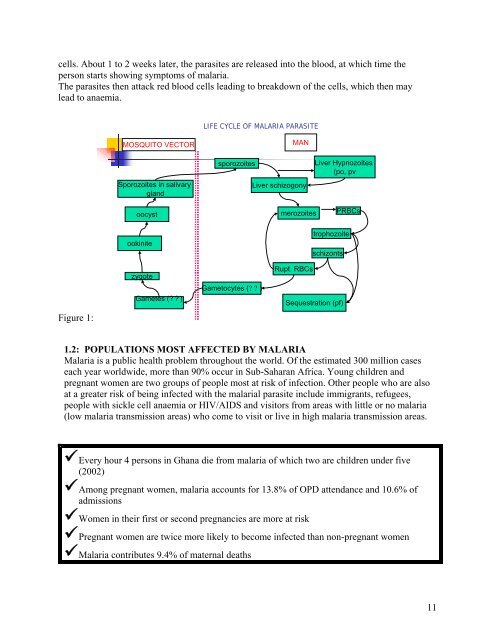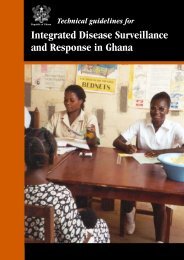Training Manual for Preventive Malaria - Ministry of Health
Training Manual for Preventive Malaria - Ministry of Health
Training Manual for Preventive Malaria - Ministry of Health
You also want an ePaper? Increase the reach of your titles
YUMPU automatically turns print PDFs into web optimized ePapers that Google loves.
cells. About 1 to 2 weeks later, the parasites are released into the blood, at which time the<br />
person starts showing symptoms <strong>of</strong> malaria.<br />
The parasites then attack red blood cells leading to breakdown <strong>of</strong> the cells, which then may<br />
lead to anaemia.<br />
LIFE CYCLE OF MALARIA PARASITE<br />
MOSQUITO VECTOR<br />
Sporozoites in salivary<br />
gland<br />
sporozoites<br />
MAN<br />
Liver schizogony<br />
Liver Hypnozoites<br />
(po, pv<br />
oocyst<br />
merozoites<br />
PRBCs<br />
Figure 1:<br />
ookinite<br />
zygote<br />
Gametes (? ? )<br />
Gametocytes (? ?)<br />
trophozoite<br />
schizonts<br />
Rupt. RBCs<br />
Sequestration (pf)<br />
1.2: POPULATIONS MOST AFFECTED BY MALARIA<br />
<strong>Malaria</strong> is a public health problem throughout the world. Of the estimated 300 million cases<br />
each year worldwide, more than 90% occur in Sub-Saharan Africa. Young children and<br />
pregnant women are two groups <strong>of</strong> people most at risk <strong>of</strong> infection. Other people who are also<br />
at a greater risk <strong>of</strong> being infected with the malarial parasite include immigrants, refugees,<br />
people with sickle cell anaemia or HIV/AIDS and visitors from areas with little or no malaria<br />
(low malaria transmission areas) who come to visit or live in high malaria transmission areas.<br />
Every hour 4 persons in Ghana die from malaria <strong>of</strong> which two are children under five<br />
(2002)<br />
Among pregnant women, malaria accounts <strong>for</strong> 13.8% <strong>of</strong> OPD attendance and 10.6% <strong>of</strong><br />
admissions<br />
Women in their first or second pregnancies are more at risk<br />
<br />
Pregnant women are twice more likely to become infected than non-pregnant women<br />
<strong>Malaria</strong> contributes 9.4% <strong>of</strong> maternal deaths<br />
11















